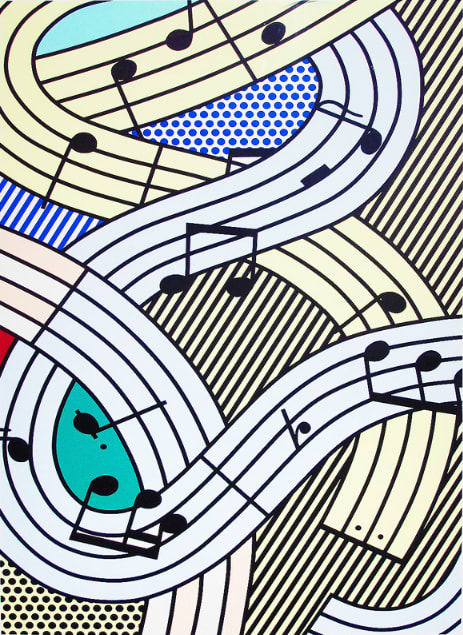
Roy Lichtenstein
99.1 x 73.7 cm
Roy Lichtenstein’s Composition I (C. 297), created in 1996, demonstrates the artist’s lifelong fascination with visual rhythm, structure, and the translation of sound into image. Here, musical notation—staff lines, notes, and bars—unfurls across the surface in bold sweeps, weaving into a complex yet tightly ordered composition. The screen print exemplifies Lichtenstein’s ability to distill the dynamism of one medium (music) into the rigid mechanics of another (graphic art).
The curling, intersecting staves mimic both movement and melody, their curves suggesting the flow of a symphonic score made visible. The bold black notes punctuate the field like beats, while splashes of primary color—blue, yellow, red—recall Lichtenstein’s signature Pop palette. This use of color, contained yet vibrant, creates a harmony that mirrors musical intervals, offering the viewer both a visual and conceptual score.
As with his Brushstroke works of the 1960s, Lichtenstein engages in a meta-commentary on artistic creation. Just as the Brushstrokes transformed the expressive gesture of painting into a mechanical, Pop icon, Composition I mechanizes the ephemeral nature of music into a crisp, static graphic language. The ephemeral becomes permanent, the flowing becomes structured, and sound is transformed into sight.
The print also resonates with modernist traditions of synesthesia, recalling artists such as Wassily Kandinsky who sought to render music as visual abstraction. However, where Kandinsky pursued the spiritual and transcendent, Lichtenstein embraces the commercial, the mechanical, and the flat—appropriating a universal language of notation and stripping it of its acoustic dimension. What remains is a bold, ironic meditation on art’s ability to represent what cannot be fixed: time, rhythm, and sound.
Created near the end of his career, Composition I reflects Lichtenstein’s continued exploration of how art can deconstruct its own languages. It stands as both a celebration of music’s vitality and a witty reduction of its infinite fluidity into Pop Art’s characteristic grammar of lines, dots, and color blocks.
For more information or to buy Composition I (C. 297) by Roy Lichtenstein, contact our galleries using the form below.
Join our mailing list
* denotes required fields
We will process the personal data you have supplied in accordance with our privacy policy (available on request). You can unsubscribe or change your preferences at any time by clicking the link in our emails.
This website uses cookies
This site uses cookies to help make it more useful to you. Find out more about cookies.


